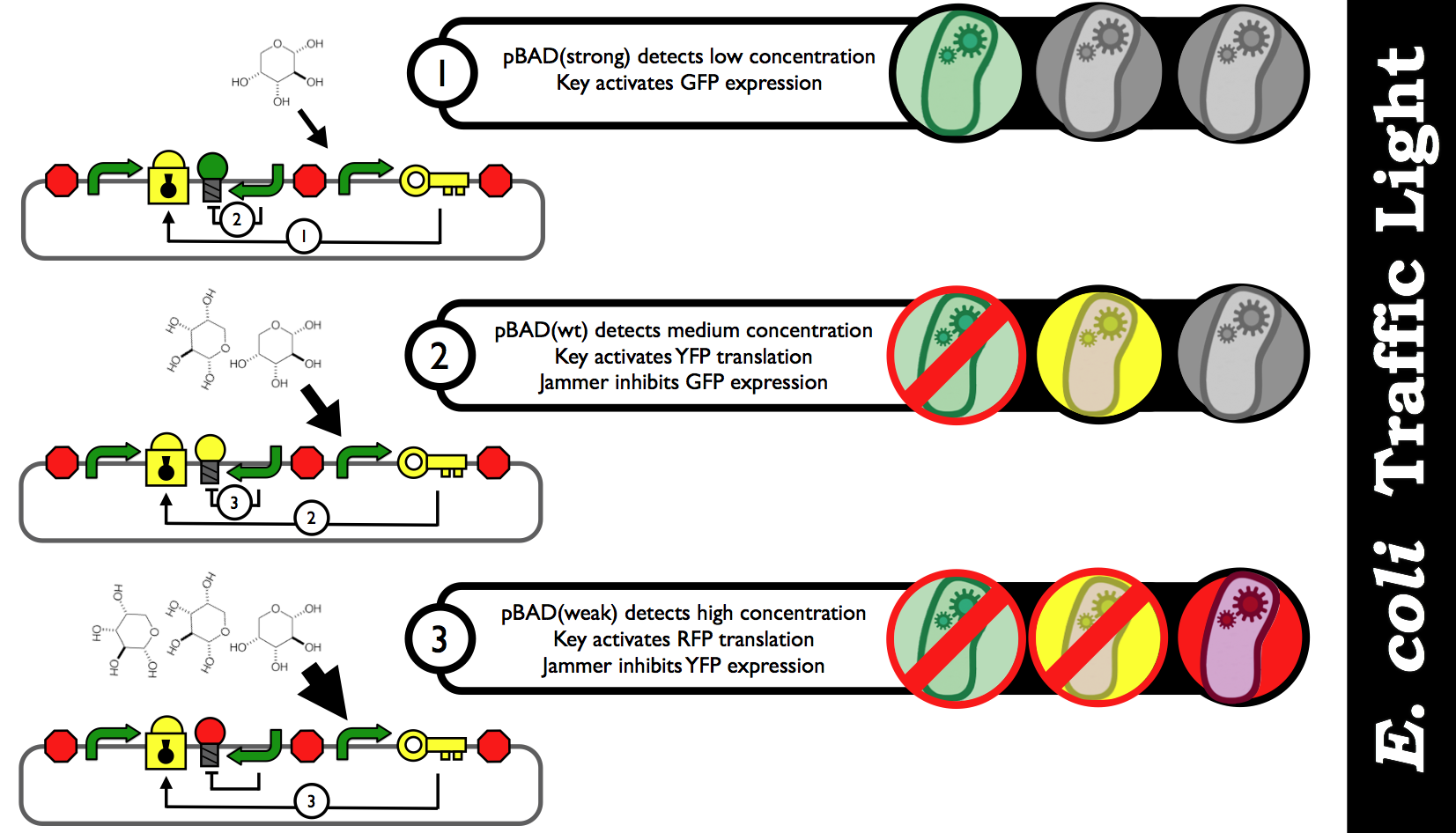Team:British Columbia/Project
From 2009.igem.org
(Difference between revisions)
(→Traffic Light Overview) |
|||
| (22 intermediate revisions not shown) | |||
| Line 2: | Line 2: | ||
<!--- The Mission, Experiments ---> | <!--- The Mission, Experiments ---> | ||
| - | == | + | ==Traffic Light Overview== |
| - | + | Depending on the concentration of a particular substrate in the medium, E. coli will respond accordingly by producing different coloured fluorescence proteins. A diagram would look like this: | |
| - | [[Image:E_coli_Traffic_Light_Subprojects.png|center|thumb|| | + | [[Image:E_coli_Traffic_Light_Subprojects.png|center|thumb||600px|The ''E. coli'' Traffic Light Biosensor is composed of three major subparts: variable arabinose-inducible promoters, RNA lock and key system, and reverse antisense promoters for input detection, color activation and traffic light switching respectively.]] |
| - | + | Here is what's happening inside our traffic light: | |
| - | 1. [ | + | |
| - | 2. A lock-and-key logic gate system<br> | + | [[Image:E_coli_Traffic_Light_Step_by_Step.png|thumb|center|850px|Schematic black-box representation of the E. coli Biosensor that detects various concentration inputs and color outputs. The idea is discrete analog outputs based on a user-specified threshold for each range of concentration.]] |
| - | 3. An antisense "off" switch | + | |
| + | For our ideas to work, we will need:<br> | ||
| + | 1. [https://2009.igem.org/Team:British_Columbia/pBAD A variable sensitivity biosensor]<br> | ||
| + | 2. [https://2009.igem.org/Team:British_Columbia/LockandKey A lock-and-key logic gate system]]<br> | ||
| + | 3. [https://2009.igem.org/Team:British_Columbia/Jammer An antisense "off" switch] | ||
<!-- !!!!!!!make sure the spacer is enough so that the image doesn't run into the next section --> | <!-- !!!!!!!make sure the spacer is enough so that the image doesn't run into the next section --> | ||
| - | + | <br><br><br> | |
<!-- | <!-- | ||
| Line 42: | Line 46: | ||
--> | --> | ||
| - | == | + | == Tools used and produced == |
| - | + | To assist our project, we produced a Biobrick digestion engine and Biobrick picture maker to help out the project: | |
| - | |||
:http://www.pkts.ca/bb - Biobrick digestion engine - enter the name of a biobrick plasmid and biobrick insert, and this will show you the product of an EcoRI and PstI digestion/ligation as a FASTA file (suitable for viewing in your favorite program). | :http://www.pkts.ca/bb - Biobrick digestion engine - enter the name of a biobrick plasmid and biobrick insert, and this will show you the product of an EcoRI and PstI digestion/ligation as a FASTA file (suitable for viewing in your favorite program). | ||
:http://www.pkts.ca/brickedit/ - Biobrick picture maker - enter a sequence of letters corresponding to the icons, and the program will produce a concatenated file of the Biobrick. | :http://www.pkts.ca/brickedit/ - Biobrick picture maker - enter a sequence of letters corresponding to the icons, and the program will produce a concatenated file of the Biobrick. | ||
| - | = | + | Also, we generated a handy Fasta file containing every biobrick from [http://partsregistry.org/cgi/partsdb/pgroup.cgi?pgroup=List Here]: |
| + | :[[Media:Biobricks.zip|Biobricks.zip]] - Fasta file containing every biobrick | ||
| + | |||
| + | We also found the following tools very helpful: | ||
| - | http://rna.tbi.univie.ac.at/ - a package of prediction tools for RNA structures; we used RNAfold to annotate the key and lock structures | + | :http://rna.tbi.univie.ac.at/ - a package of prediction tools for RNA structures; we used RNAfold to annotate the key and lock structures |
| - | http://mobyle.pasteur.fr/cgi-bin/portal.py - a set of web-accessible bioinformatics tools including Mfold, which determines 2D RNA structure and draws it | + | :http://mobyle.pasteur.fr/cgi-bin/portal.py - a set of web-accessible bioinformatics tools including Mfold, which determines 2D RNA structure and draws it |
| - | http://frodo.wi.mit.edu/ - Primer3, a primer design program | + | :http://frodo.wi.mit.edu/ - Primer3, a primer design program |
Latest revision as of 03:08, 22 October 2009
[http://www.ubc.ca ]
[http://www.ubc.ca ]
Traffic Light Overview
Depending on the concentration of a particular substrate in the medium, E. coli will respond accordingly by producing different coloured fluorescence proteins. A diagram would look like this:
Here is what's happening inside our traffic light:
For our ideas to work, we will need:
1. A variable sensitivity biosensor
2. A lock-and-key logic gate system]
3. An antisense "off" switch
Tools used and produced
To assist our project, we produced a Biobrick digestion engine and Biobrick picture maker to help out the project:
- http://www.pkts.ca/bb - Biobrick digestion engine - enter the name of a biobrick plasmid and biobrick insert, and this will show you the product of an EcoRI and PstI digestion/ligation as a FASTA file (suitable for viewing in your favorite program).
- http://www.pkts.ca/brickedit/ - Biobrick picture maker - enter a sequence of letters corresponding to the icons, and the program will produce a concatenated file of the Biobrick.
Also, we generated a handy Fasta file containing every biobrick from [http://partsregistry.org/cgi/partsdb/pgroup.cgi?pgroup=List Here]:
- Biobricks.zip - Fasta file containing every biobrick
We also found the following tools very helpful:
- http://rna.tbi.univie.ac.at/ - a package of prediction tools for RNA structures; we used RNAfold to annotate the key and lock structures
- http://mobyle.pasteur.fr/cgi-bin/portal.py - a set of web-accessible bioinformatics tools including Mfold, which determines 2D RNA structure and draws it
- http://frodo.wi.mit.edu/ - Primer3, a primer design program
 "
"

